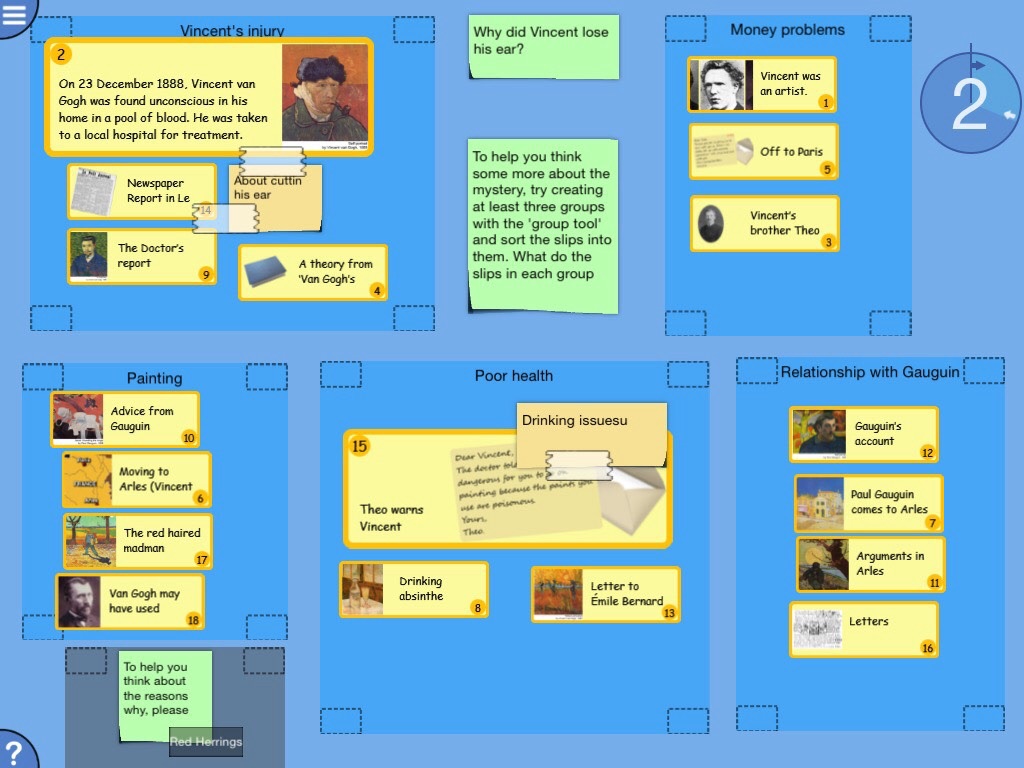
Vincent van Gogh (Art/English)
Digital Mysteries: Vincent van Gogh is a unique app for 7-11 year olds which allows pairs to work simultaneously on one iPad with a task mapped to the art/English curriculum .
Users are given illustrated slips of information which they read, organise into groups and lay out across the screen. These are all about the interesting story of Vincent van Gogh’s life, and the controversy surrounding how he came to lose an ear, to introduce students to his – and fellow artist Paul Gauguin’s – work. It can be used to contribute to the requirement to teach pupils about great artists in history.
The 18 slips include letters between Vincent and his brother, a diagnosis of Vincent’s health by Doctor Rey, a newspaper report and statements of many of the people involved. While these are central to the story itself, the mystery also brings in many of Vincent’s paintings which can be viewed very clearly in the largest slip size. There is also a self-portrait by Paul Gauguin included too.
It is hoped that the students will be engaged in the dramatic story behind the famous artist while at the same time be able to learn about his style and whether/how it was different to others. The mystery could be used to support the development of group discussion and interaction, as well as encourage students in their development of generic thinking skills.
Once students have finished and came up with their own answer to ‘why did Vincent lose his ear?’ they can generate a printable PDF report which outlines the session; students involved, their notes, groups and answer, as well as colourful screenshots of each stage. They can also go to a Reflection Stage in which they can playback the process and discuss it as a group, with their teacher or even as a class.
Who is this app for?
Digital Mysteries: Vincent van Gogh works well with those aged 7-11 years old as it covers elements of the KS2 national curriculum for England.
The task might serve as a spring board to further research comparing and contrasting the differing approaches and subject matters of Vincent van Gogh and Paul Gauguin.
What’s different about Digital Mysteries?
• Truly collaborative: It is unique in that more than one student can interact with it at once
• Record of learning: Students can interact and have fun with exciting technology, then generate a printable PDF report of their session which shows what they’ve done
• Cross-curricular: Mysteries come in various topics plus many are cross-curricular in themselves
• Reflection: Sessions are automatically recorded so students can playback and discuss what they’ve done, emphasising the importance of the process as well as the outcome
• Speaking and listening: Due to its collaborative nature, each session aligns to this learning goal, plus ‘group discussion and interaction’
• Engagement: Working in pairs adds to the fun experience of problem-solving
• Research: We’ve done years of academic research on how to make the most of touch screens for learning in general, and collaboration specifically
What does a mystery consist of?
• Illustrated slips of information: Short snippets to help students with reading
• Open question: To maximise the potential of collaboration, discussion and expression of ideas, the nature of the task is usually open ended
• Extras: Most tasks come with personalised hints for those who need them, e.g. suggestions for organising ideas or simpler stage introductions to ease them in
• Description: This gives teachers the information they need to plan their session including the curriculum point each task links to, the advised age range and possible learning outcomes
How can I try other mysteries?
At the bottom of the app details tab, tap ‘Developer Apps’ to view our current range.



